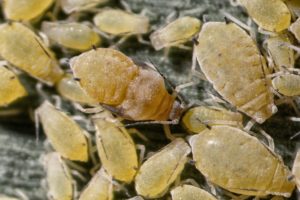New sugarcane aphid early warning system debuts
AgriLife Extension effort monitors pests’ seasonal movement
Writer: Steve Byrns, 325-651-4824, [email protected]
Contact: Dr. Allen Knutson, 972-952-9222, [email protected]
DALLAS – A minuscule pest few Texas farmers had ever heard of three years ago has quickly gained notoriety as the most important insect pest of grain and forage sorghum in Texas, said an expert entomologist.
The pest is the sugarcane aphid, and it’s already been found infesting sorghum in the lower Rio Grande Valley and lower Gulf Coast this year, said Dr. Allen Knutson, Texas A&M AgriLife Extension Service entomologist at Dallas. As in past years, the sugarcane aphid is expected to move into Central Texas and eventually the Texas High Plains, potentially infesting all of Texas’ sorghum-producing regions by late summer.

“Grain and forage sorghum producers can now monitor the progression of the sugarcane aphid across Texas via an online mapping program conducted by AgriLife Extension in cooperation with Kansas State University,” Knutson said.
The sugarcane aphid distribution map can be accessed at https://www.myfields.info.
“Growers and consultants can use the map to determine where sugarcane aphids have been found in sorghum fields across the state and anticipate the need to scout fields to determine aphid infestation levels in their area.”
Since it was first discovered feeding on sorghum in 2013, the sugarcane aphid has become an annual pest, infesting both grain and forage sorghums. The tiny insect sucks plant sap, causing leaves to yellow and die, thus reducing yields, Knutson said. In addition to the feeding damage to the crop, the aphids’ sticky excrement called honeydew, can actually become so heavy that it can gum up combines and forage harvesters, rendering them inoperable.
Knutson said the monitoring system is manned by a network of AgriLife Extension entomologists who report sugarcane aphid presence in sorghum on a county-wide basis from the Rio Grande Valley through the upper Gulf Coast, North and Central Texas, the South Plains and High Plains; essentially all of Texas’ sorghum producing regions.
Once sugarcane aphid is found in a county, Knutson said the report is posted online through the MyFields.info program developed at Kansas State University. Information from AgriLife Extension on scouting, thresholds, insecticides and integrated pest management practices for sugarcane aphid is also posted on the site.
Danielle Sekula, AgriLife Extension integrated pest management agent in Weslaco, said sugarcane aphid was first reported this year in Texas on March 21 in the Lower Rio Grande Valley. Dr. Robert Bowling, AgriLife Extension entomologist at Corpus Christi, confirmed that by April 28, the pest had been documented on sorghum in 15 counties in the Lower Rio Grande Valley and Lower Gulf Coast.
“Sugarcane aphids overwinter on Johnsongrass in South and Central Texas and likely move into planted sorghum in the early summer,” Bowling said. “As their numbers increase in northern Mexico and South Texas in the weeks ahead, I expect to see more winged aphids moving north into the Gulf Coast region.”
How can such a tiny insect cover so many miles so quickly? Knutson said adult aphids with wings develop in the aphid colony as it becomes crowded and food quality declines. Although these winged aphids are weak fliers, it’s believed they are carried by the wind from field to field and over very long distances.
“Sugarcane aphid infestations, especially in Central and West Texas, likely result from long distance dispersal of wind-blown aphids from South Texas,” he said. “By using the sugarcane aphid mapping site, growers and consultants can monitor the movement of sugarcane aphids as they move across the state. The mapping project also supports the U.S. Department of Agriculture’s Agricultural Research Service program studying the long-distance movement of sugarcane aphid from South Texas to Oklahoma and Kansas.”
Insecticides are effective for control of sugarcane aphid, but Bowling said applications must be properly timed before aphid numbers begin to rapidly increase and damage the crop.
“It’s important to remember these aphids can build their populations to extremely large numbers in a very short time, so scout early and don’t delay treatments once infestations reach the crop-damage threshold,” Bowling said. “Using the Sugarcane Aphid Distribution Map is a classic case of forewarned is forearmed.”
For more information on sugarcane aphid, see the AgriLife Extension websites http://txscan.blogspot.com/ and http://betteryield.agrilife.org/.


